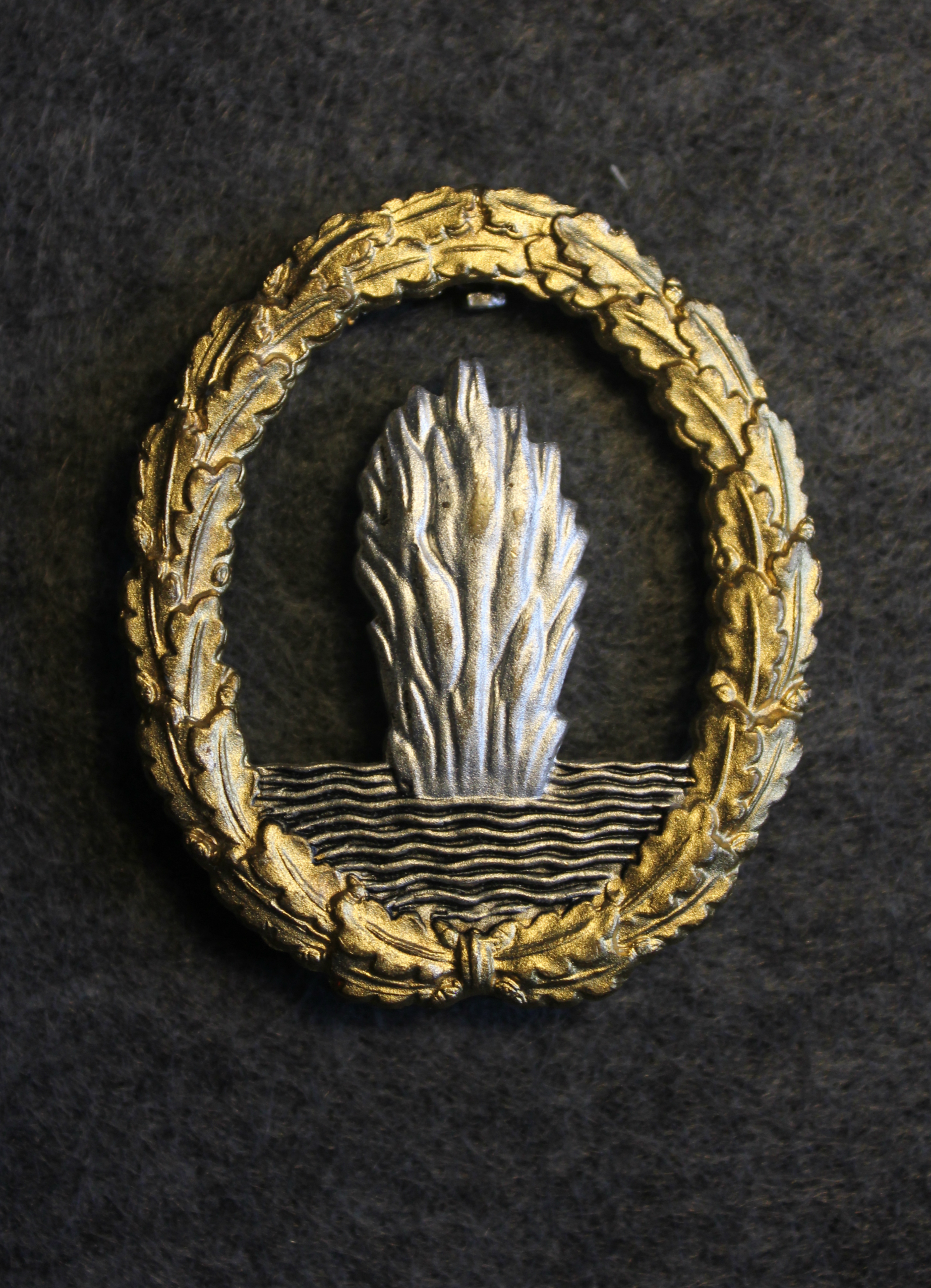Minesweeper War Badge on:
[Wikipedia]
[Google]
[Amazon]
 The Minesweeper War Badge or Minesweepers, Sub-Chasers and Escort-Vessel War Badge () was a
The Minesweeper War Badge or Minesweepers, Sub-Chasers and Escort-Vessel War Badge () was a
 The Minesweeper War Badge or Minesweepers, Sub-Chasers and Escort-Vessel War Badge () was a
The Minesweeper War Badge or Minesweepers, Sub-Chasers and Escort-Vessel War Badge () was a World War II
World War II or the Second World War (1 September 1939 – 2 September 1945) was a World war, global conflict between two coalitions: the Allies of World War II, Allies and the Axis powers. World War II by country, Nearly all of the wo ...
German
German(s) may refer to:
* Germany, the country of the Germans and German things
**Germania (Roman era)
* Germans, citizens of Germany, people of German ancestry, or native speakers of the German language
** For citizenship in Germany, see also Ge ...
military decoration awarded to Kriegsmarine
The (, ) was the navy of Nazi Germany from 1935 to 1945. It superseded the Imperial German Navy of the German Empire (1871–1918) and the inter-war (1919–1935) of the Weimar Republic. The was one of three official military branch, branche ...
members for service on minesweeper
A minesweeper is a small warship designed to remove or detonate naval mines. Using various mechanisms intended to counter the threat posed by naval mines, minesweepers keep waterways clear for safe shipping.
History
The earliest known usage of ...
s vessels. The award was instituted on 31 August 1940 by Grand Admiral
Grand admiral is a historic naval rank, the highest rank in the several European navies that used it. It is best known for its use in Germany as . A comparable rank in modern navies is that of admiral of the fleet.
Grand admirals in individual ...
Erich Raeder
Erich Johann Albert Raeder (24 April 1876 – 6 November 1960) was a German admiral who played a major role in the naval history of World War II and was convicted of war crimes after the war. He attained the highest possible naval rank, that of ...
. It was first awarded on 28 November 1940.
Design
The medal, designed by Otto Placzek of Berlin, consists of an outer laurel wreath of oak leaves with the national emblem of an eagle clutching a swastika (both golden coloured) at its apex. The central area features a representation of a sea mine exploding. The medal was first produced inbronze
Bronze is an alloy consisting primarily of copper, commonly with about 12–12.5% tin and often with the addition of other metals (including aluminium, manganese, nickel, or zinc) and sometimes non-metals (such as phosphorus) or metalloid ...
and later in zinc. Inferior quality late-war versions can appear a dull gray as the gold gilt was known to wear off.
The medal was worn on the lower part of the left breast pocket of the naval service tunic, underneath the 1st class Iron Cross
The Iron Cross (, , abbreviated EK) was a military decoration in the Kingdom of Prussia, the German Empire (1871–1918), and Nazi Germany (1933–1945). The design, a black cross pattée with a white or silver outline, was derived from the in ...
if awarded, or equivalent grade award.
Criteria for award
Award of this medal could derive from: * The candidate had completed at least three operational sorties * Wounded during an operational sortie * Ship he was sailing in an operation was sunk due to enemy action * Participated in a specific sortie that proved very successfully * Had shown exemplary conduct in the execution of his duties over a six-month period * Completed a specially dangerous mission in a mined area * Served on escort duty for 25 days or morePost-War
After the official establishment of the West German government in 1949, and the sub-subsequent founding of the new German Navy in 1956, the ''Bundesmarine'' found many of its ships crewed by former ''Kriegsmarine
The (, ) was the navy of Nazi Germany from 1935 to 1945. It superseded the Imperial German Navy of the German Empire (1871–1918) and the inter-war (1919–1935) of the Weimar Republic. The was one of three official military branch, branche ...
s''.
Following a similar directive as the rest of the ''Bundeswehr
The (, ''Federal Defence'') are the armed forces of the Germany, Federal Republic of Germany. The is divided into a military part (armed forces or ''Streitkräfte'') and a civil part, the military part consists of the four armed forces: Germ ...
,'' the Bundesmarine allowed several de-nazified versions of World War II medals, which had been previously earned and issued, to be worn. The decision to allow re-issued versions of these medals to be worn was made after a Federal decision in 1957. Thereafter, a select number of medals pertaining to combat and civilian service with the Wehrmacht (Nazi party medals were not re-issued) were produced. These medals were re-issued to retired and active members of the former ''Kriegsmarine
The (, ) was the navy of Nazi Germany from 1935 to 1945. It superseded the Imperial German Navy of the German Empire (1871–1918) and the inter-war (1919–1935) of the Weimar Republic. The was one of three official military branch, branche ...
''. Members of the Bundesmarine who had not served during the war were not eligible to receive this medal.
These 1957 re-issued medals are identical in most respect to their wartime equivalents, the most prominent difference being the removal of the German eagle and Swastika. Post-war Minesweeper medals were produced by a wide variety of German medal manufacturers between the 1960s–1980s. These new medals often do not bear a makers mark. They also sometimes utilize some newer medals in their construction.
Notes
References
* * Klietmann, Kurt-Gerhard (1981). ''Auszeichnungen des Deutschen Reiches. 1936–1945''. Motorbuch, Stuttgart. . {{List of military decorations of the Third Reich , state=collapsed Kriegsmarine Military awards and decorations of Nazi Germany